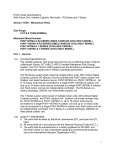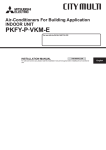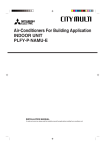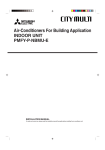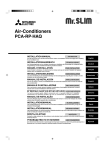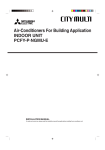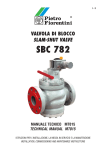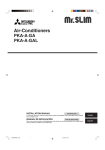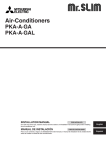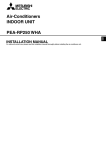Download Mitsubishi Electric PKFY-P.NFMU-E Installation manual
Transcript
Air-Conditioners For Building Application INDOOR UNIT PKFY-P·NAMU-E PKFY-P·NGMU-E PKFY-P·NFMU-E INSTALLATION MANUAL For safe and correct use, please read this installation manual thoroughly before installing the air-conditioner unit. Contents 1. 2. 3. 4. Safety precautions ................................................................................... Installation location .................................................................................. Installing the indoor unit ........................................................................... Installing the refrigerant piping ................................................................. 2 3 3 9 5. Drainage piping work .............................................................................. 11 6. Electrical work ........................................................................................ 13 7. Test run .................................................................................................. 16 1. Safety precautions s Before installing the unit, make sure you read all the “Safety precautions”. s Please report to your supply authority or obtain their consent before connecting this equipment to the power supply system. Warning: Describes precautions that must be observed to prevent danger of injury or death to the user. Caution: Describes precautions that must be observed to prevent damage to the unit. Warning: • Ask a dealer or an authorized technician to install the unit. • For installation work, follow the instructions in the Installation Manual and use tools and pipe components specifically made for use with refrigerant specified in the outdoor unit installation manual. • The unit must be installed according to the instructions in order to minimize the risk of damage from earthquakes, typhoons, or strong winds. An incorrectly installed unit may fall down and cause damage or injuries. • The unit must be securely installed on a structure that can sustain its weight. • If the air conditioner is installed in a small room, measures must be taken to prevent the refrigerant concentration in the room from exceeding the safety limit in the event of refrigerant leakage. Should the refrigerant leak and cause the concentration limit to be exceeded, hazards due to lack of oxygen in the room may result. After installation work has been completed, explain the “Safety Precautions,” use, and maintenance of the unit to the customer according to the information in the Operation Manual and perform the test run to ensure normal operation. Both the Installation Manual and Operation Manual must be given to the user for keeping. These manuals must be passed on to subsequent users. : Indicates a part which must be grounded. Warning: Carefully read the labels affixed to the main unit. • Ventilate the room if refrigerant leaks during operation. If refrigerant comes into contact with a flame, poisonous gases will be released. • All electric work must be performed by a qualified technician according to local regulations and the instructions given in this manual. • Use only specified cables for wiring. • The terminal block cover panel of the unit must be firmly attached. • Use only accessories authorized by Mitsubishi Electric and ask a dealer or an authorized technician to install them. • The user should never attempt to repair the unit or transfer it to another location. • After installation has been completed, check for refrigerant leaks. If refrigerant leaks into the room and comes into contact with the flame of a heater or portable cooking range, poisonous gases will be released. 1.1. Before installation (Euvironment) Caution: • Do not use the unit in an unusual environment. If the air conditioner is installed in areas exposed to steam, volatile oil (including machine oil), or sulfuric gas, areas exposed to high salt content such as the seaside, the performance can be significantly reduced and the internal parts can be damaged. • Do not install the unit where combustible gases may leak, be produced, flow, or accumulate. If combustible gas accumulates around the unit, fire or explosion may result. • Do not keep food, plants, caged pets, artwork, or precision instruments in the direct airflow of the indoor unit or too close to the unit, as these items can be damaged by temperature changes or dripping water. • When the room humidity exceeds 80% or when the drainpipe is clogged, water may drip from the indoor unit. Do not install the indoor unit where such dripping can cause damage. • When installing the unit in a hospital or communications office, be prepared for noise and electronic interference. Inverters, home appliances, high-frequency medical equipment, and radio communications equipment can cause the air conditioner to malfunction or breakdown. The air conditioner may also affect medical equipment, disturbing medical care, and communications equipment, harming the screen display quality. 1.2. Before installation or relocation Caution: • Be extremely careful when transporting the units. Two or more persons are needed to handle the unit, as it weighs 44 lbs. (20 kg) or more. Do not grasp the packaging bands. Wear protective gloves as you can injure your hands on the fins or other parts. • Be sure to safely dispose of the packaging materials. Packaging materials, such as nails and other metal or wooden parts may cause stabs or other injuries. • Thermal insulation of the refrigerant pipe is necessary to prevent condensation. If the refrigerant pipe is not properly insulated, condensation will be formed. • Place thermal insulation on the pipes to prevent condensation. If the drainpipe is installed incorrectly, water leakage and damage to the ceiling, floor, furniture, or other possessions may result. • Do not clean the air conditioner unit with water. Electric shock may result. • Tighten all flare nuts to specification using a torque wrench. If tightened too much, the flare nut can break after an extended period. 1.3. Before electric work Caution: • Be sure to install circuit breakers. If not installed, electric shock may result. • For the power lines, use standard cables of sufficient capacity. Otherwise, a short circuit, overheating, or fire may result. • When installing the power lines, do not apply tension to the cables. • Be sure to ground the unit. If the unit is not properly grounded, electric shock may result. • Use circuit breakers (ground fault interrupter, isolating switch (+B fuse), and molded case circuit breaker) with the specified capacity. If the circuit breaker capacity is larger than the specified capacity, breakdown or fire may result. 1.4. Before starting the test run Caution: • Turn on the main power switch more than 12 hours before starting operation. Starting operation just after turning on the power switch can severely damage the internal parts. • Before starting operation, check that all panels, guards and other protective parts are correctly installed. Rotating, hot, or high voltage parts can cause injuries. 2 • Do not operate the air conditioner without the air filter set in place. If the air filter is not installed, dust may accumulate and breakdown may result. • Do not touch any switch with wet hands. Electric shock may result. • Do not touch the refrigerant pipes with bare hands during operation. • After stopping operation, be sure to wait at least five minutes before turning off the main power switch. Otherwise, water leakage or breakdown may result. 2. Installation location ■ PKFY-P06/P08NAMU-E in.(mm) 2.1. Installation location • • • • • • • Mount the indoor unit on a wall strong enough to withstand the weight of the unit. Select a location so that air can be blown into all corners of the room. Avoid locations exposed to outside air. Select a location free of obstructions to the airflow in and out of the unit. Avoid locations exposed to steam or oil vapour. Avoid locations where combustible gas may leak, settle or be generated. Avoid installation near machines emitting high-frequency waves. (high-frequency welders, etc.) • Avoid locations where the airflow is directed at a fire alarm sensor. (Hot air could trigger the alarm during the heating operation.) • Avoid places where acidic solutions are frequently handled. • Avoid places where sulphur-based or other sprays are frequently used. Obstacle ■ PKFY-P12/P15NGMU-E 2.2. Outline dimensions and service space (Fig. 2-1) Select a proper position allowing the following clearances for installation and maintenance. Warning: Mount the indoor unit on a wall strong enough to withstand the weight of the unit. ∗ For PKFY-P06/08NAMU-E Leave a service space of 2-1/8 in. (54 mm) or more for left or left-rear piping. Obstacle ■ PKFY-P18/P24/P30NFMU-E ■ PKFY-P18/P24/P30NFMU-E in. (mm) A Models P18/P24NFMU-E P30NFMU-E A 55-1/8 (1400) 66-1/8 (1680) Obstacle Fig. 2-1 3. Installing the indoor unit ■ PKFY-P06/P08NAMU-E ¡ 3.1. Check the indoor unit accessories and parts (Fig. 3-1) ™ The indoor unit comes with the following parts and accessories: ■ PKFY-P06/P08NAMU-E PARTNUMBER ¡ ™ £ ¢ £ ACCESSORY Mount board Tapping screw 4 × 35 Felt tape MA remote controller cable QUANTITY 1 8 1 1 LOCATION OF SETTING Fix at the back of the unit Set in packing material ¢ Fig. 3-1 3 3. Installing the indoor unit ■ PKFY-P12/P15NGMU-E ■ PKFY-P12/P15NGMU-E (Fig. 3-2) PARTNUMBER ACCESSORY ¡ Mount board ™ Tapping screw 4 × 35 £ Pipe cover ¢ Band ∞ Felt tape § Joint pipe ¶ Mount piece ™ ¡ £ ¢ ∞ § QUANTITY 1 12 1 5 3 1 1 LOCATION OF SETTING Fix at the back of the unit Set inside the unit Set in packing ¶ Fig. 3-2 ■ PKFY-P18/P24/P30NFMU-E ■ PKFY-P18/P24/P30NFMU-E (Fig. 3-3) ¡ ™ £ ¢ PARTNUMBER 1 2 3 4 5 6 7 8 ∞ § ¶ • ACCESSORY Wall-fixing bracket Tapping screw 4 × 35 Pipe cover Band Felt tape Drain socket Joint pipe Flare nut P18 QUANTITY LOCATION OF SETTING 1 Fix at the back of the unit 12 2 4 (large) + 5 (small) 3 Set inside the unit 1 1 2 <ø3/8" (9.52), ø5/8" (15.88)> Fig. 3-3 ■ PKFY-P06/P08NAMU-E N 17-23/32 (450) 17-23/32 (450) 4-5/16 (109.5) C D 3-1/8 (79.5) 12-29/32 (328) 11-23/32 (298) F I E H G 4-5-16 (109.5) J 1-19/32 (40.5) 1/8 (3) M L 7-3/4 (196.5) 9-21/32 (245.5) 11-5/32 (283) A B 11/32 (9) in.(mm) 10-1/4 (260) 7-15/32 (190) 3-1/8 (79.5) K W 3-15/16 (100) B 5 * The hole position on the left side is 5-1/8 inch (130 mm) from scale slot department. 10 X Z Y Fig. 3-4 4 3.2. Installing the mount board 1) Setting the mount board and piping positions s Using the mount board, determine the unit’s installation position and the locations of the piping holes to be drilled. Warning: Before drilling a hole in the wall, you must consult the building contractor. ■ PKFY-P06/P08NAMU-E (Fig. 3-4) A B C D E F G H I J K L M N Supporting piece Mount board ¡ Contour of the unit Slot (4P-3/16" × 1-3/8" (4-4.5 × 35 mm)) Hole (8P-5/32" dia. (8-ø4.3 mm)) Level setting standard Knockout hole Hole (12P-1/8" dia. (12-ø2.8 mm)) Bolt hole (4P-11/32" dia. (4-ø9 mm)) Screw hole (87P-3/16" dia. (87-ø5.1 mm)) Piping hole (2-9/16" to 2-3/4" dia. (ø65-ø70 mm)) Slot (4P-3/16" × 1-9/16" (4-4.5 × 40 mm)) Slot (4P-3/16" × 1-15/32" (4-4.5 × 37 mm)) Slot (4P-7/16" × 25/32" (4-11 × 20 mm)) W: Location for wall holes X Insert scale. Y Hole centre Z Align the scale with the line. 3. Installing the indoor unit F in.(mm) 19-1/2 (495) 12-19/32 (320) 13-19/32 (345) 10-1/4 (260) 8-1/16 (205) 5-29/32 (150) 5-5/16 (135) E 2-15/16 (75) 1-1/4 (32) 25/32 (20) 0 1-3/8 (35) 31/32 (25) 3-3/4 (95) A 7-15/32 (190) 9-21/32 (245) 11-13/16 (300) 15-15/16 (405) 19-1/2 (495) D 14-3/16 (360) ■ PKFY-P12/P15NGMU-E B 0 1-3/8 (35) 2-5/32 (55) 3-5/32 (80) 5-1/8 (130) 7-15/32 (190) 9-1/16 (230) C N K 16-23/32 (425) 6-11/16 (170) 7-15/32 (190) M 0 1-9/16 (40) L 5-1/2 (140) 16-17/32 (420) 9-1/16 (230) 8-9/32 (210) 10-23/32 (272) 12-7/32 (310) 12-11/16 (322) 13-3/8 (340) I 1) Setting the mount board and piping positions s Using the mount board, determine the unit’s installation position and the locations of the piping holes to be drilled. G H ■ PKFY-P12/P15NGMU-E (Fig. 3-5) J B W 3-15/16 (100) Warning: Before drilling a hole in the wall, you must consult the building contractor. A B C D E F G H I J K L M N Supporting piece Mount board ¡ Contour of the unit Slot (6P-7/16" × 25/32" (6-11 × 20 mm)) Unit center Bolt hole (14P-9/16" dia. (14-ø14 mm)) Screw hole (49P-3/16" dia. (49-ø5 mm)) Hole for left-rear piping (3-17/32" to 3-9/16" dia. (ø75 mm-ø90 mm)) Knockout hole for left-rear piping Hole for right-rear piping (3-17/32" to 3-9/16" dia. (ø75 mm-ø90 mm)) Knockout hole for right-rear piping Liquid pipe flare connection position Gas pipe flare connection position Level setting standard W: Location for wall holes X Insert scale. Y Hole centre Z Align the scale with the line. Y X Z Fig. 3-5 A in.(mm) s Using the wall-fixing bracket , determine the unit’s installation position and the locations of the piping holes to be drilled. D E 8-27/32 (225) 9-7/16 (240) 7-3/32 (180) F 11-1/32 (280) 12-3/8 (314) 24-1/32 (610) H 3-17/32 (90) 11-1/32 (280) G 3-19/32 (91) C B 2-3/8 (60) 23/32 (18) 11-7/32 (285) 3/4 (19) 13/32 (10) 1-3/16 (30) 1-5/32 (29) 23/32 (18) 1) Setting the wall-fixing bracket and piping positions 17-29/32 (455) 13/32×3-19/32= (35-13/16) (10×91= (910)) 35-7/16 (900) Warning: Before drilling a hole in the wall, you must consult the building contractor. Caution: The unit body must be mounted horizontally. I ■ PKFY-P30NFMU-E D E 9-21/32 (245) 23-7/16 (595) B 11-5/8 (295) 8-27/32 (225) 11-7/32 (285) 3/4 (19) 35-7/16 (900) 23/32 (18) C 9-71/16 (240) 7-3/32 (180) 3-19/32 (91) 11-1/32 (280) 12-3/8 (314) 29-17/32 (750) H F 7-1/4 (184) 13/32 (10) 1-3/16 (30) 1-3/16 (30) 3-5/32 (80) 1-5/32 (29) (60) 11-1/32 (280) 2-3/8 2-3/8(60) 23/32 (18) A 50 (1270) 1/2×3-19/32=(46-9/16) (13×91=(1183)) 3-17/32 (90) H A B C D E F G H I Indoor unit centre line Left drain range Right drain range Screw hole Bolt hole Screw hole Contour of the unit Knockout hole for left-rear piping Rear piping access hole (3-9/16 to 4 in. dia. (90 to 100 mm dia.)) 1-3/16 (30) G ■ PKFY-P18/P24/P30NFMU-E (Fig. 3-6) 9-21/32 (245) 7-1/4 (184) 1-3/16 (30) 3-5/32 (80) 3-5/32(80) 38-31/32 (990) 1-3/16 (30) ■ PKFY-P18/P24NFMU-E I Fig. 3-6 2) Drilling the piping hole (Fig. 3-7) s Use a core drill to make a hole of X diameter in the wall in the piping direction, at the position shown in the diagram on page 4, 5. s The hole should incline so that the outside opening is lower than the inside opening. s Insert a sleeve (with a Y diameter and purchased locally) through the hole. in.(mm) B A Models PKFY-P06/P08 PKFY-P12/P15 PKFY-P18/P24/P30 X 2-5/16 to 2-3/4 (65-70) 2-15/16 to 3-5/32 (75-80) 3-9/16 to 4 (90-100) Y 2-9/16 (65) 2-15/16 (75) 3-9/16 (90) Note: The purpose of the hole’s inclination is to promote drain flow. C E D Fig. 3-7 A B C D E Sleeve Hole (Indoors) Wall (Outdoors) 5 3. Installing the indoor unit ■ PKFY-P12/P15NGMU-E in.(mm) 1 Min.2-3/16 ( 55) Min.1-3/16 (30) ■ PKFY-P06/P08NAMU-E 1 C Min.5/8 Min.5-1 (130) 5/16 Min.3-1 Min.4 (100) (100) Min.11-13/16 (300) Min.5-1/2 (140) 2 2 Min.2-3/8 (60) ■ PKFY-P18/P24NFMU-E Min.19-11/16 (500) s Selection of the mounting location requires thorough consideration. If the wall does not seem to be strong enough, reinforce it with boards or beams before installation. s The mount board (the wall-fixing bracket) must be secured at both ends and at the centre, if possible. Never fix it at a single spot or in any nonsymetrical way. (If possible, secure the fixture at all the positions indicated with a bold arrow.) s If securing the mount board with bolts, use commercially available M10 or W3/8 bolts (through bolts, anchor nuts, etc.). • Make sure that the bolt tip does not protrude more that 5/8 in. (15 mm) from the wall surface. • Use at least two bolts for a concrete wall, and at least four bolts for a foamed concrete wall. s If securing the mount board with tapping screws, use the included accessory screws ™ or commercially available screw that are 5/32 in. (4 mm) in diameter and 1-3/8 in. (35 mm) or more in length. • If securing the mount board to ferroconcrete, use concrete screws or commercially available anchor plugs. Warning: If possible, secure the fixture at all positions indicated with a bold arrow. Wall-fixing bracket Min.6-1/2 (165) Caution: • The unit body must be mounted horizontally. • Fasten at the holes marked withe c as shown by the arrows. Min.2-3/8 (60) ■ PKFY-P30NFMU-E 3) Installing the mount board (the wall-fixing bracket) (Fig.3-8) 1 Fasten a thread to the hole 2 The level can be easily obtained by hanging a weight from the string and aligning the string with the mark. Min.19-11/16 (500) Wall-fixing bracket Min.6-1/2 (165) Fig. 3-8 ■ PKFY-P06/P08NAMU-E ■ PKFY-P12/P15NGMU-E 3.3. When embedding pipes into the wall (Fig.3-9) B A C • The pipes are on the bottom left. • When the refrigerant pipe, drain pipes internal/external connection lines etc are to be embedded into the wall in advance, the extruding pipes etc, may have to be bent and have their length modified to suit the unit. • Use marking on the mount board (wall-fixing bracket) as a reference when adjusting the length of the embedded cooling pipe. • During construction, give the length of the extruding pipes etc some leeway. A B C D D ■ PKFY-P18/P24/P30NFMU-E Mount board (wall-fixing bracket) ¡ Reference marking for flare connection Through hole Piping (Purchased locally) C 3.4. Preparation for piping connection (Fig.3-10) Rear, right and lower piping Bind the refrigerant pipes and drain pipe with vinyl tape at three or more points. This will facilitate passing the pipes through the wall. A D Fig. 3-9 A Vinyl tape ■ PKFY-P06/P08NAMU-E 1 A D E B C 2 F B C D E F G Wall Wall hole Bent section Refrigerant pipe Drain pipe Transmission cable 2. Lift the indoor unit by hooking the supporting piece (attached to the mount board) to the ribs on the back of the unit as shown. When piping work etc. is complete, replace the supporting piece on the mount board. (If the unit is not fixed securely, vibration may occur during operation.) 3 H H Mount board ¡ I Supporting piece J Rib I J G Left and left-rear piping 1. For left-rear piping, pull the pipes out the hole to determine their correct length, then bend them. The indoor unit should hang on the mount board. K Fig. 3-10 3. If the flare pipe is to be embedded into the wall in advance: • Determine the length of pipe to be embedded by marking on the mount board as a reference. K Mark 6 3. Installing the indoor unit ■ PKFY-P06/P08NAMU-E C 3.5. Mounting the indoor unit (Fig. 3-11) C 1. Securely place the hanging fixtures for the indoor unit over the catches on the mount board. A Indoor unit B Mount board ¡ C Catch 2. When piping has been completed, install the indoor unit and mount board with fixing screws. B A Fig. 3-11 3.6. Remove the front panel (Fig. 3-12) ■ PKFY-P06/P08NAMU-A (Remove the front panel to check the electrical wiring connections and the drain for proper drainage.) • Before removing the front panel, open the guide vane 13/16 to 1-3/16 in. (2-3 cm). 1. Remove the screw caps, then the screws. 2. Pull the left side of the front panel from the air conditioner, then the right side. 3. Pull the bottom of the front panel out, then the top of the front panel to remove the panel. * Be sure not to remove the nozzle assembly when removing the front panel. 2 4 Push 1, 3 Guide vane Screw 3.7. Installing the front panel (Fig. 3-13) Fig. 3-13 Fig. 3-12 1. 2. 3. 4. ■ PKFY-P12/P15NGMU-E Insert the bottom of the front panel into the air conditioner under the guide vane. Set the top of the front panel. Set the bottom of the front panel, and then install the screws. Push the front panel at the arrow marks to fix it to the air conditioner. Install the screw caps. 3.8. Preparation for piping connection Rear, right and lower piping (Fig. 3-14) 1. Bind the refrigerant pipe and drain pipe together. • Bind the refrigerant pipes and drain pipe with vinyl tape at three or more points. This will facilitate passing the pipes through the wall. 2. Remove the corner box and knock out the knockout holes as necessary. • Remove the corner box by pushing in a downward direction b, while at the same time, pressing in the upper side part of the corner box a. a A b A Right corner box Fig. 3-14 Left and left rear piping (Fig. 3-15) 1. Remove the under cover. • Remove the under cover by sliding it towards the rear of the unit b, while at the same time, pressing the two points marked by arrow heads a. 2. Remove the corner box and knock out the knockout holes as necessary. • Remove the corner box by pushing in a downward direction d, while at the same time, pressing in the upper side part of the corner box c. c C d B Under cover C Left corner box B b a * Fig. 3-15 ■ PKFY-P12/P15NGMU-E in.(mm) C The drain hose can be connected at two different positions. Use the most convenient position and, if necessary, exchange the position of the drain pan, rubber plug and the drain hose. (For connecting instructions, refer to page 11,12) 3.9. Mounting the indoor unit 1. Affix the mount board to the wall. 2. Hang the indoor unit on the two hooks positioned on the upper part of the mount board. Fig. 3-16 D E F B A D Fig. 3-17 1-3/16 to 1-9/16 (30 to 40) A Square hole B Hooks C Catch Rear, right and lower piping (Fig. 3-16) 3. Affix the indoor unit. 4. After connecting the pipes, put the corner box back to where it was (follow the removal steps backwards). Left and left rear piping (Fig. 3-17) 3. Cut out a mounting piece from the packaging material. 4. Pull the indoor unit up towards yourself as shown in the figure below and slide the mounting piece in to the mount board using the mounting piece setting marks as reference. 5. After connecting the pipes and wiring, put the under cover back to where it was, and remove the mounting piece and affix the indoor unit as shown in the left figure. 6. Put the corner box back to where it was. D Mounting piece § E Ceiling F Rib 7 3. Installing the indoor unit ■ PKFY-P18/P24/P30NFMU-E 1 3.10. Preparation for piping connection Remove the vinyl band that holds the drain piping. • This vinyl band can be used to temporarily attach the pipes to the mount board while connecting the left pipe. Rear, right and lower piping (Fig. 3-18) 1 Remove the right side panel. Left and left rear piping (Fig. 3-19) 1 Remove the right and left side panels. 2 Remove the five screws indicated by the arrows in the diagram. 3 Remove the left side panel, then the lower panel. • While pushing up the front lower portion of the side panel (to disengage the side panel catch from the unit catch), slide the upper portion of the side panel to the left. • When the indoor unit is already mounted, be sure the unit does not fall from the mount board. • For reassembly, put the catch at the front lower portion of the side panel over the unit body and push it to the right. Fig. 3-18 2 ∗ 1. 2. 3. 4. 5. B C 3 Structure of the side panel and the unit body Panel catch engages the unit body catch. Panel catch is put in the unit body hole. Panel catch engages the unit body catch. Sheet metal of the unit body enters the panel. Panel catch enters the unit body hole. 4 The drain hose can be connected at two different positions. Use the most convenient position and, if necessary, exchange the position of the drain pan, rubber plug and the drain hose. (For connecting instructions, refer to page 11, 12.) D D A Right side panel B Left side panel C Lower panel ✽ E D Catch E Side panel F Unit body F 5 4 3 2 1 Fig. 3-19 ■ PKFY-P18/P24/P30NFMU-E 1 3.11. Mounting the indoor unit (Fig. 3-20) A 1 Make sure to hang the metal catches of the indoor unit over the hooks of the mount board. 2 When the piping has been completed, use the securing screws to fix the indoor unit on the mount board. B Note: Check that the catches of the indoor unit securely fit over the hooks of the mount board. 2 E D C 3 3 The screw indicated by the bold arrow is used only during transportation and should be removed. Remove the screw before installation if there is not enough space at the left side to remove it once the unit has been installed. A B C D E Fig. 3-20 8 Indoor unit Wall fixing bracket ¡ Hook Metal catch of the indoor unit Securing screws 4. Installing the refrigerant piping 4.1. Precautions 4.1.1. For devices that use R22 refrigerant • Use the refrigeration oil applied to the flared sections. • Use C1220 copper phosphorus, for copper and copper alloy seamless pipes, to connect the refrigerant pipes. Use refrigerant pipes with the thicknesses specified in the table to the below. Make sure the insides of the pipes are clean and do not contain any harmful contaminants such as sulfuric compounds, oxidants, debris, or dust. 4.1.2. For devices that use R410A refrigerant • Use ester oil, ether oil, alkylbenzene oil (small amount) as the refrigeration oil applied to the flared sections. • Use C1220 copper phosphorus, for copper and copper alloy seamless pipes, to connect the refrigerant pipes. Use refrigerant pipes with the thicknesses specified in the table to the below. Make sure the insides of the pipes are clean and do not contain any harmful contaminants such as sulfuric compounds, oxidants, debris, or dust. Warning: When installing or moving the air conditioner, use only the specified refrigerant (R410A) to charge the refrigerant lines. Do not mix it with any other refrigerant and do not allow air to remain in the lines. Air enclosed in the lines can cause pressure peaks resulting in a rupture and other hazards. in. (mm) Liquid pipe Gas pipe P06, P08, P12, P15 P18, P24, P30 1/4" (ø6.35) thickness 1/32" (0.8) 3/8" (ø9.52) thickness 1/32" (0.8) 1/2" (ø12.7) thickness 1/32" (0.8) 5/8" (ø15.88) thickness 3/64" (1.0) • Do not use pipes thinner than those specified above. A B 45°±2° 4.2. Connecting pipes (Fig. 4-1) øA /6 R1 90° ±0.5° C 2 1/3 oR 4t D Fig. 4-1 • When commercially available copper pipes are used, wrap liquid and gas pipes with commercially available insulation materials (heat-resistant to 212 °F (100 °C) or more, thickness of 1/2 in. (12 mm) or more). • The indoor parts of the drain pipe should be wrapped with polyethylene foam insulation materials (specific gravity of 0.03, thickness of 23/64 in. (9 mm) or more). • Apply thin layer of refrigerant oil to pipe and joint seating surface before tightening flare nut. • Use two wrenches to tighten piping connections. • Use refrigerant piping insulation provided to insulate indoor unit connections. Insulate carefully. B Flare nut tightening torque A Flare cutting dimensions Copper pipe O.D. 1/4" (ø6.35) 3/8" (ø9.52) 1/2" (ø12.7) 5/8" (ø15.88) 3/4" (ø19.05) in. (mm) Copper pipe O.D. in. (mm) 1/4" (ø6.35) 1/4" (ø6.35) 3/8" (ø9.52) 1/2" (ø12.7) 1/2" (ø12.7) 5/8" (ø15.88) 5/8" (ø15.88) 3/4" (ø19.05) Flare dimensions øA dimensions 11/32-23/64 (8.7 - 9.1) 1/2-33/64 (12.8 - 13.2) 41/64-21/32 (16.2 - 16.6) 49/64-25/32 (19.3 - 19.7) 15/16-61/64 (23.6 - 24.0) A Available pipe size A B in. (mm) A Copper pipe O.D. 1/4" (ø6.35) 3/8" (ø9.52) 1/2" (ø12.7) 5/8" (ø15.88) 3/4" (ø19.05) Tightening torque ft·lbs. (N·m) 10-13 (14 - 18) 25-30 (34 - 42) 25-30 (34 - 42) 35-44 (49 - 61) 49-59 (68 - 82) 49-59 (68 - 82) 72-87 (100 - 120) 72-87 (100 - 120) C Apply refrigerating machine oil over the entire flare seat surface. D Use correct flare nuts meeting the pipe size of the outdoor unit. A Die B Copper pipe Fig. 4-2 Flare nut O.D. in. (mm) 43/64 (17) 7/8 (22) 7/8 (22) 1-3/64 (26) 1-9/64 (29) 1-9/64 (29) 1-27/64 (36) 1-27/64 (36) P06, P08 P12, P15 P18 1/4" (ø6.35) 1/4" (ø6.35) 1/4" (ø6.35) Liquid side – – 3/8" (ø9.52) 1/2" (ø12.7) 1/2" (ø12.7) 1/2" (ø12.7) Gas side – – 5/8" (ø15.88) – – – : Factory flare nut attachment to the heat-exchanger. in. (mm) P24, P30 – 3/8" (ø9.52) – 5/8" (ø15.88) – Flare tool for R22 Flare tool for R410A Clutch type 0-1/64 (0 - 0.5) 3/64-1/16 (1.0 - 1.5) 0-1/64 (0 - 0.5) 3/64-1/16 (1.0 - 1.5) 0-1/64 (0 - 0.5) 3/64-1/16 (1.0 - 1.5) 0-1/64 (0 - 0.5) 3/64-1/16 (1.0 - 1.5) 0-1/64 (0 - 0.5) 3/64-1/16 (1.0 - 1.5) 9 4. Installing the refrigerant piping ■ PKFY-P06/P08NAMU-E 4.3. Positioning refrigerant and drain piping 1 in.(mm) B C 4-11/32 (110) 26-31/32 (660) A ■ PKFY-P06/P08NAMU-E (Fig. 4-3) 1 Position of refrigerant and drain piping • The drain pipe can be cut midway to meet the on-site conditions. A B C D D (Total length of flexible hose) Liquid pipe Gas pipe Drain hose 2 Determine the position of the knockout holes on the unit body. 17-23/32 (450) C 4-9/16 20-25/32 (520) B (116) 2 E s Cut the knockout holes using a saw blade or an adequate knife. Take care not to damage other parts of the unit. F G • Remove the corner box and drill a knockout hole. If a hole is made without removing the box, the drain hose could be damaged. I L (10) 13/32 (10 10) (50) 50) 1-31/32 (50 J 5/8 (16) K H K 13/32 (10) 3/32 (2.5) 3/32 (2.5) 5/32 (4) 13/32 1-25/32 (10) (45) 5/8 (16) I E F G H I J K L 1-31/32 (50) 2-1/8 (54) 31/32 (24.4) 1-11/32 (34) 1-25/32 3-19/32 (45) (91.5) Left-side piping Lower piping Right-side piping Knockout hole for left-side piping Corner box Knockout hole for lower piping Through hole for the remote controller’s cable Knockout hole for right-side piping Fig. 4-3 ■ PKFY-P12/P15NGMU-E 1-7/32 (31) 22-7/8 (581) 17-11/16 (449) B C 27-9/16 (700) A D E 6-1/32 (153) F D F • Remove the corner box and drill a knockout hole. If a hole is made without removing the box, the drain hose could be damaged. I H 7/8 (22) I H 5/16 (8) 1-3/8 (35) 2-3/4 (70) 7-15/32 (190) 2-3/8 (60) I 2-3/8 (60) 13/32 (10) 7/8 (22) 2-3/4 (70) 5/16 (8) 13/32 (10) 13/32 (10) 13/16 (21) 2-3/4 (70) 7/8 (22) 2-3/8 (60) H 5/16 (8) s Cut the knockout holes using a saw blade or an adequate knife. Take care not to damage other parts of the unit. G 2 D Drain hose E Left-side piping F Right-side piping 2 Determine the position of the knockout holes on the unit body. B 2-1/8 (54) 3-3/8 (86) E Left-side piping F Lower piping G Right-side piping 9-21/32 (245) E A (Total length of flexible hose) B Liquid pipe C Gas pipe C H Remote controller cable through hole I Corner box 13/16 (21) 1-3/8 (35) 9-21/32 (245) in.(mm) 11-1/32 (280) 1 ■ PKFY-P12/P15NGMU-E (Fig. 4-4) 1 Position of refrigerant and drain piping • The drain pipe can be cut midway to meet the on-site conditions. Fig. 4-4 ■ PKFY-P18/P24/P30NFMU-E C in.(mm) D in.(mm) Models P18/P24NFMU-E P30NFMU-E 1-21/32 (42) 2-9/32 (58) 1 ■ PKFY-P18/P24/P30NFMU-E 1 Position of refrigerant and drain piping (Fig. 4-5) 2-5/32 (55) 4-23/32 (120) B E 43-11/16 (1110) B B 31/32 (25) 7-7/32 (183) D A 4-3/8 (111) C B C D E Fig. 4-5 2 F G A 4-7/32 (107) 4-1/32 (102) Drain hose Liquid pipe Gas pipe Drain hose in left-side piping • The drain pipe can be cut midway to meet the on-site conditions. H 2 Determine the position of the knockout holes on the unit body. (Fig. 4-6) 1-15/32 (37) 2-9/16 (65) F For left-side piping G For lower-side piping H For right-side piping 1-3/16 (30) 1-15/32 (37) 2-29/32 (74) 3-27/32 (98) 3-15/16 (100) 1-17/32 (39) 2-9/16 (32) 1-15/32 (37) 2-29/32 (74) Fig. 4-6 • Make the knockout holes using a saw blade or an adequate knife. Caution: The side panel must be removed before drilling a knockout hole in it. If a hole is made with the side panel in place, the refrigerant pipe within the unit could be damaged. 1-17/32 (39) 5/32 (4) 5/32 (4) 3-15/16 (100) 1-17/32 (39) 1-3/16 (30) 3 3 L-shaped connection pipe (for gas piping) (Fig. 4-7) 3-1/6 (80) 13-3/8 (340) M J L Fig. 4-7 10 K J J K L M L-shaped connection pipe (optional parts) Unit side On-site piping side Piping (purchased locally) Caution: These items are used for right, lower or left side piping. 4. Installing the refrigerant piping ■ PKFY-P06/P08NAMU-E Working process A Refrigerant piping and insulation (purchased locally) B Unit's refrigerant piping C On-site refrigerant piping D Vinyl tape ■ PKFY-P06/P08NAMU-E (Fig. 4-8) 1. Remove the flare nut and cap of the indoor unit. 2. Make a flare for the liquid pipe and gas pipe and apply refrigerating machine oil (available from your local supplier) to the flare sheet surface. 3. Quickly connect the on site pipes to the unit. 4. Wrap the pipe cover of the unit and make sure that it covers the insulation material of the on site liquid pipe. 5. Insulating material of combining it department is covered with the vinyl tape. Fig. 4-8 ■ PKFY-P12/P15NGMU-E B D C E G F A A On site pipe and insulation (available from local supplier) B Unit’s gas pipe C Unit’s liquid pipe D Pipe cover £ E Bands ¢ F On site gas pipe G On site liquid pipe Fig. 4-9 ■ PKFY-P18/P24/P30NFMU-E E B A B C D E F A Gas pipe Liquid pipe Pipe cover £ Band (large) ¢ Band (small) ¢ On site pipe and insulation (available from local supplier) G Thermal insulating material for liquid pipe H Vinyl tape (Purchased locally) I L-connection pipe (gas pipe) (optional parts) D I C E D G H ■ PKFY-P12/P15NGMU-E (Fig. 4-9) 1. Remove the flare nut and cap of the indoor unit. 2. Make a flare for the liquid pipe and gas pipe and apply refrigerating machine oil (available from your local supplier) to the flare sheet surface. 3. Quickly connect the on site pipes to the unit. 4. Wrap the pipe cover £ that is attached to the gas pipe and make sure that the connection join is not visible. 5. Wrap the pipe cover of the unit’s liquid pipe and make sure that it covers the insulation material of the on site liquid pipe. 6. Use the bands ¢ that are provided to tighten both ends (3/4 in. (20 mm)) of each pipe cover £. ■ PKFY-P18/P24/P30NFMU-E (Fig. 4-10) 1. Remove the flare nut and cap of the indoor unit. 2. Make a flare for the liquid pipe and gas pipe and apply refrigerating machine oil (available from your local supplier) to the flare sheet surface. 3. Quickly connect the on site pipes to the unit. 4. Wrap the pipe cover £ that is attached to the gas pipe and make sure that the connection join is not visible. 5. Wrap the pipe cover of the unit’s liquid pipe and make sure that it covers the insulation material of the on site liquid pipe. 6. Use the bands ¢ that are provided to tighten both ends (3/4 in. (20 mm)) of each pipe cover £. F Fig. 4-10 5. Drainage piping work 5.1. Drainage piping work (Fig. 5-1) a d b e i g c c c f h ■ PKFY-P06/P08NAMU-E C in. a b c d e f g h i E ID13/16 OD13/16 B ID7/8 ID1-1/16 B ■ PKFY-P12/P15NGMU-E C D AB ID13/16 ID1-1/16 ID7/8 E OD13/16 B F D A B Inclined downwards Must be lower than outlet point Water leakage Trapped drainage Air Wavy The end of drain pipe is under water. Drainage ditch 2 in. (5 cm) or less between the end of drain pipe and the ground Caution: The drain pipe should be installed according to this Installation Manual to ensure correct drainage. Thermal insulation of the drain pipes is necessary to prevent condensation. If the drain pipes are not properly installed and insulated, condensation may drip on the ceiling, floor or other possessions. ■ PKFY-P18/P24/P30NFMU-E C • Drain pipes should have an inclination of 1/100 or more. • Use PVC pipe for drain piping. • Drain pipes can be cut with a knife at the connection point according to the on-site conditions. • When connecting the PVC pipe, use adhesive to attach the supplied drain socket. • Do not put the drain pipes directly in a drainage ditch where sulphuric gas may be generated. • Confirm that water is not leaking at the drain pipe connections. • When piping has been completed, check to make sure that water flows from the end of the drain pipe. Drain pipe connection A B C D E F Drain socket § Apply PVC adhesive (purchased locally) here for bonding On-site drain pipe Unit’s drain pipe (drain hose) Joint pipe ¶ (for use when the size of on-site piping does not fit) Band ¢ Fig. 5-1 11 5. Drainage piping work ■ PKFY-P12/P15NGMU-E 1 ■ PKFY-P12/P15NGMU-E (Fig. 5-2) Preparing left and left rear piping The drain hose can be connected at two different positions. Use the most convenient position and, if necessary, exchange the position of the drain pan, rubber plug and the drain hose. 1 Remove the drain cap. • Remove the drain cap by holding the bit that sticks out at the end of the pipe and pulling. 2 A a b 3 A Drain cap 2 Remove the drain hose. • Remove the drain hose by holding on to the base of the hose a (shown by arrow) and pulling towards yourself b. 3 Insert the drain cap. • Insert a screwdriver etc into the hole at the end of the pipe and be sure to push to the base of the drain cap. 4 Insert the drain hose. • Push the drain hose until it is at the base of the drain box connection outlet. • Please make sure the drain hose hook is fastened properly over the extruding drain box connection outlet. 4 B A Fig. 5-2 B Hooks ■ PKFY-P18/P24/P30NFMU-E ■ PKFY-P18/P24/P30NFMU-E (Fig. 5-3) The drain hose can be connected at two different positions. Use the most convenient position and, if necessary, exchange the position of the drain pan, rubber plug and the drain hose. A H C D B G A A B C D E E F I Drain pan Rubber plug Metal band Drain hose Screwdriver F G H I Insert the screwdriver into the hole of the rubber plug and push. Exchange if necessary. The screw of the metal clamp should be positioned facing the wall. Band (small) ¢ • Remove the drain hose after loosening the screw on the metal band used to mount it. • Securely insert both the rubber plug and drain hose into the drain outlets. • Install the metal band around the drain hose and the small enclosed band around the rubber plug. Be sure the bands are securely fastened so that there is no leakage. EF B Fig. 5-3 ■ PKFY-P06/P08NAMU-E in.(mm) E B 4(100) F C D I Felt tape £ Liquid pipe Gas pipe Drain pipe Viewed from the back Take care that the middle of the drain hose is not raised. In the case of left piping, the refrigerant pipes and the drain pipe should be taped separately. Wrap together the refrigerant pipes and the drain pipe with felt tape so that white felt overlaps by 20 mm or more. * The pipes should be wrapped so that they are housed behind the unit. I Fix the end of the felt tape with a bandage fixture. G Fig. 5-4 ■ PKFY-P12/P15NGMU-E (Fig. 5-5) Using the unit’s pipe storage space (for left and left rear piping) • To prevent cooling pipes from gathering moisture, wrap the pipes that are in the unit’s pipe storage space with the felt tape provided. • When wrapping with the felt tape, be sure to double over by no more than half the width of the tape. • Use a bandage clip etc to fasten the end to the felt tape. ■ PKFY-P12/P15NGMU-E A B C D A C B D Gas pipe Liquid pipe Felt tape ∞ Drain pipe C Fig. 5-5 ■ PKFY-P18/P24/P30NFMU-E E F I B A ;;;;;;;;; H G J D Fig. 5-6 12 ■ PKFY-P06/P08NAMU-E (Fig. 5-4) Using the unit’s pipe storage space (for left and left rear piping) • To prevent condensation from dripping, put felt tape over the insulation materials on the refrigerant and drain pipes within the unit as shown in the diagram. • Arrange the drain hose so that it goes to the bottom of the unit. • The overlapping width of felt tape is one half of the tape width. A B C D E F G H A H 5.2. Completing the piping C ■ PKFY-P18/P24/P30NFMU-E (Fig. 5-6) Using the unit’s pipe storage space (for left and left rear piping) • To prevent dripping condensation, put felt tape over the insulation materials on the refrigerant and drain pipes within the unit as shown in the diagram. • Arrange the drain hose so that it goes to the bottom of the unit. Take care that the middle of the drain hose is not raised. A B C D E F G H I J Felt tape ∞ Liquid pipe Gas pipe Drain pipe Viewed from the back Two refrigerant pipes are wrapped together. A single drain hose is wrapped with felt tape. Two refrigerant pipes are wrapped with felt tape from the end of the bent section. Overlapping width of felt tape is one half of the tape width or less. Secure the end of the felt tape with a bandage fixture. 5. Drainage piping work ■ PKFY-P·NAMU-E ■ PKFY-P·NFMU-E 5.3. Drain check (Fig. 5-7) Pour water in the drainpan and check that it comes out the drain pipe end, after confirmation, reinstall the panel. ■ PKFY-P·NGMU-A Fig. 5-7 6. Electrical work ■ PKFY-P06/P08NAMU-E 6.1. Precautions Warning: Electrical work should be done by qualified electrical engineers in accordance with “Engineering Standards For Electrical Installation” and supplied installation manuals. Special circuits should also be used. If the power circuit lacks capacity or has an installation failure, it may cause a risk of electric shock or fire. M J I K L E G D C F H G A B C D E F G H I J K L M Electric parts cover Corner box Terminal block for power supply Terminal block for transmission cable (Shared with the M-NET remote controller) Connector for MA remote controller MA remote controller cable ¢ Cable clamp Address board Conduit plate Lock nut (Purchased locally) Connector (Purchased locally) Conduit (Purchased locally) Bush (Purchased locally) I 1. Be sure to take power from the special branch circuit. 2. Be sure to install an earth leakage breaker to the power. 3. Install the unit to prevent that any of the control circuit cables (remote controller, transmission cables) is brought in direct contact with the power cable outside the unit. 4. Ensure that there is no slack on all wire connections. 5. Some cables (power, remote controller, transmission cables) above the ceiling may be bitten by mouses. Use as many metal pipes as possible to insert the cables into them for protection. 6. Never connect the power cable to leads for the transmission cables. Otherwise the cables would be broken. 7. Be sure to connect control cables to the indoor unit, remote controller, and the outdoor unit. 8. Put the unit to the ground on the indoor unit side. 9. Select control cables from the conditions given in “Types of control cable”. Caution: Be sure to put the unit to the ground on the indoor unit side also. Do not connect the earth cable to any gas pipe, water pipe, lightening rod, or telephone earth cable. Incomplete grounding may cause a risk of electric shock. Working process Fig. 6-1 ■ PKFY-P12/P15NGMU-E A J G F H I ■ PKFY-P06/P08NAMU-E (Fig. 6-1) 1. Remove the front panel, then remove the corner box from the lower right corner of the indoor unit. 2. Install each wire into the unit. 3. Remove the tapping screw (1), and then remove the electric parts cover. 4. Connect each wire properly to the terminal block. • In consideration of future servicing, please leave some leeway for the wiring length. • Route the wires as shown in the illustration. (Do not route the wires in front of the address board cover.) • If using the MA remote controller, connect it to the connector for the accessory remote controller cable ¢. 5. Put all the parts back the way they were. 6. Use a clamp from the bottom of the electric parts box to fasten each wire. s Fix power source wiring to control box using buffer bushing for tensile force. (PG connection or the like.) A means for the disconnection of the supply with an isolation switch, or similar device, in all active conductors shall be incorporated in the fixed wiring. A Terminal block cover B Terminal block for power supply C Terminal block for transmission line and M-NET remote controller D Terminal block for MA remote controller E Cable clamp F Conduit plate G Lock nut (Purchased locally) H Conector (Purchased locally) I Conduit (Purchased locally) J Bush (Purchased locally) K Address board Fig. 6-2 ■ PKFY-P12/P15NGMU-E (Fig. 6-2) 1. Remove the corner box. 2. Install each wire into the unit. 3. Open the front grill, remove the tapping screw (1), and then remove the terminal block cover. 4. Connect each wire properly to the terminal block. • In consideration of future servicing, please leave some leeway for the wiring length. 5. Put all the parts back the way they were. 6. Use a clamp from the bottom of the electric parts box to fasten each wire. s Fix power source wiring to control box using buffer bushing for tensile force. (PG connection or the like.) A means for the disconnection of the supply with an isolation switch, or similar device, in all active conductors shall be incorporated in the fixed wiring. 13 6. Electrical work ■ PKFY-P18/P24/P30NFMU-E 1 C 2 AB ■ PKFY-P18/P24/P30NFMU-E (Fig. 6-3) 1. Remove the right-side panel. 2. Install each wire into the unit. 3. Remove the tapping screw (1), and then remove the terminal block cover by sliding it to the right and up. 4. Connect each wire properly to the terminal block. • In consideration of future servicing, please leave some leeway for the wiring length. 5. Put all the parts back the way they were. 6. Use a clamp from the bottom of the electric parts box to fasten each wire. s Fix power source wiring to control box using buffer bushing for tensile force. (PG connection or the like.) F G D H K E I J O 3 L K M A B TB3 M1 M2 B TB5 TB15 TB5 M1 M2 S 1 2 M1 M2 S *1 A M1 M2 TB3 1 2 *2 E C B B M1 M2 S M1 M2 S TB5 1 2 E C 2 • Connect indoor unit TB5 and outdoor unit TB3. (Non-polarized 2-wire) The “S” on indoor unit TB5 is a shielding wire connection. For specifications about the connecting cables, refer to the outdoor unit installation manual. ∗1 Because the terminal block TB5 for the PKFY-P06/P08NAMU-E model does not have the “S” terminal, connect all of the wiring directly. • Install a remote controller following the manual supplied with the remote controller. • Connect the remote controller’s transmission cable within 33 ft (10 m) using a 0.75 mm2 (AWG18) core cable. If the distance is more than 33 ft (10 m), use a 1.25 mm2 (AWG16) junction cable. 1 MA Remote controller • Connect the “1” and “2” on indoor unit TB15 to a MA remote controller or connect the connector for MA remote controller. (Non-polarized 2-wire) • DC 9 to 13 V between 1 and 2 (MA remote controller) 2 M-NET Remote controller • Connect the “M1” and “M2” on indoor unit TB5 to a M-NET remote controller. (Nonpolarized 2-wire) • DC 24 to 30 V between M1 and M2 (M-NET remote controller) M1 M2 S 1 2 *2 E 6.2. Connecting remote controller, indoor and outdoor transmission cables (Fig. 6-4) B TB5 1 2 D Terminal block cover Securing screw on the terminal block cover Address board Printed circuit board cover Right side panel Terminal block for MA remote controller Terminal block for transmission line and M-NET remote controller Terminal block for power supply Power supply wiring & connection wiring Cable clamp Conduit plate Lock nut (Purchased locally) Connector (Purchased locally) Conduit (Purchased locally) Bush (Purchased locally) Warning: Wiring should be done so that the power lines are not subject to tension. Otherwise, heat may be generated or fire may occur. Fig. 6-3 1 N A B C D E F G H I J K L M N O C B *1 TB5 M1 M2 S A B C D E TB5 D E Terminal block for outdoor unit Terminal block for indoor unit Remote controller Transmission cables (Purchased locally) Remote control cables (Purchased locally) ∗2 Only the PKFY-P06/P08NAMU-E model has a remote control transmission cable attached to the unit for relay connections. C C C Fig. 6-4 Constraints on transmission cable (Fig. 6-5) G *1 Longest wiring length (L1+L2+L4 or L1+L3 or L2+L3+L4): less than 656 ft (200 m) Length between indoor unit and remote controller (R): within 33 ft (10 m) H I *3 J J J L1 L2 K J L K J L3 K Fig. 6-5 14 K L4 K r *2 G H I J K L Outdoor unit Ground BC controller Indoor unit M-NET Remote controller Non-polarized 2-wire Note: *1 Put the transmission cable earth via the outdoor unit’s earth terminal to the ground. *2 If the remote controller cable exceeds 33 ft (10 m), use a 1.25 mm2 (AWG16) diameter cable over the exceeded portion, and add that exceeded portion to within 656 ft (200 m). *3 The BC controller is required only for simultaneous cooling and heating series R2. 6. Electrical work Types of control cables 1. Wiring transmission cables: Shielding wire CVVS or CPEVS • Cable diameter: More than 1.25 mm2 (AWG16) 2. M-NET Remote control cables Kind of remote control cable 2-core cable (unshielded) Cable diameter More than 0.5 (AWG20) to 0.75 mm2 (AWG18) Remarks When 33 ft. (10 m) is exceeded, use cable with the same specifications as transmission line wiring (shielding portion is more than 1.25 mm2 (AWG16)) 3. MA Remote control cables Kind of remote control cable Cable diameter A B D C C C 0.3 mm2 (AWG22) to 1.25 mm2 (AWG16) 6.3. Power supply wiring (Fig. 6-6) C E A B C D E 2-core cable (unshielded) C C C Power cable size (diameter) : more than 1.6 mm (AWG14) Ground cable size (diameter) : 1.6 mm (AWG14) * Use copper supply wires. * Use the electric wires over the rating voltage 300 V. [Selecting non-fuse breaker (NF) or earth leakage breaker (NV)] To select NF or NV instead of a combination of Class B fuse with switch, use the following: • In the case of Class B fuse rated 15 A or 20 A, NF model name (MITSUBISHI): NF30-CS (15 A) (20 A) NV model name (MITSUBISHI): NV30-CA (15 A) (20 A) Use an earth leakage breaker with a sensitivity of less than 30 mA 0.1 sec. Switch 15 A Overcurrent protection 15 A Indoor unit Total operating current be less than 15 A Ground Fig. 6-6 Caution: Do not use anything other than the correct capacity breaker and fuse. Using fuse, wire or copper wire with too large capacity may cause a risk of malfunction or fire. ■ PKFY-P06/P08NAMU-E 6.4. Setting addresses (Fig. 6-7) SW5 220V (208V) 240V (230V) CN43 SW1 ON OFF CN82 1 2 3 4 5 6 7 8 9 10 SW12 SW11 SW14 0 0 0 ■ PKFY-P12/P15NGMU-E ■ PKFY-P18/P24/P30NFMU-E SW5 220V (208V) 240V (230V) CN43 Be sure to operate with the main power turned OFF. • There are two types of rotary switch setting available: setting addresses 1 to 9 and over 10, and setting branch numbers. 1 How to set addresses Example: If Address is “3”, remain SW12 (for over 10) at “0”, and match SW11(for 1 to 9) with “3”. 2 How to set branch numbers (Series R2 only) Match the indoor unit’s refrigerant pipe with the BC controller’s end connection number. Remain SW14 other than R2 at “0”. • The rotary switches are all set to “0” when shipped from the factory. These switches can be used to set unit addresses and branch numbers at will. • The determination of indoor unit addresses varies with the system at site. Set them referring to technical data. Note: Please set the switch SW5 according to the power supply voltage. • Set SW5 to 230 V side when the power supply is 230 volts. • When the power supply is 208 volts, set SW5 to 208 V side. SW1 ON OFF CN82 1 2 3 4 5 6 7 8 9 10 SW12 SW11 2 0 SWC 0 SW14 0 1 Fig. 6-7 15 6. Electrical work B 6.5. Remote controller A 1-3/16 (30) 1-37/64 (46) C A C D E F 4-23/32 (120) 1-3/16 (30) 3-9/32 (83.5) 1-3/16 (30) in.(mm) I G H Fig. 6-8 B-1. B-2. B H H I J I 1) Installing procedures (1) Select an installing position for the remote controller. (Fig. 6-8) The temperature sensors are located on both remote controller and indoor unit. s Procure the following parts locally: Two piece switch box Thin copper conduit tube Lock nuts and bushings A Remote controller profile B Required clearances surrounding the remote controller C Installation pitch (2) Seal the service entrance for the remote controller cord with putty to prevent possible invasion of dew drops, water, cockroaches or worms. (Fig. 6-9) A For installation in the switch box: B For direct installation on the wall select one of the following: • Prepare a hole through the wall to pass the remote controller cord (in order to run the remote controller cord from the back), then seal the hole with putty. • Run the remote controller cord through the cut-out upper case, then seal the cutout notch with putty similarly as above. B-1. To lead the remote controller cord from the back of the controller: B-2. To run the remote controller cord through the upper portion: (3) For direct installation on the wall C D E F G H I J Fig. 6-9 Wall Conduit Lock nut Bushing Switch box Remote controller cord Seal with putty Wood screw 2) Connecting procedures (Fig. 6-10) 1 Connect the remote controller cord to the terminal block. A A To TB5 on the indoor unit B TB6 (No polarity) AB Fig. 6-10 TB6 B 3) Temperature display setting The initial temperature display setting is °C. Please change the setting to °F. Refer to “Function selection of remote controller (Section 8)” in the operation manual for the indoor unit. 4) Two remote controllers setting If two remote controllers are connected, set one to “Main” and the other to “Sub”. For setting procedures, refer to “Function selection of remote controller” in the operation manual for the indoor unit. 7. Test run 7.1. Before test run s After completing installation and the wiring and piping of the indoor and outdoor units, check for refrigerant leakage, looseness in the power supply or control wiring, wrong polarity, and no disconnection of one phase in the supply. s Use a 500-volt megohmmeter to check that the resistance between the power Ω. supply terminals and ground is at least 1.0 MΩ F E C D B TEST RUN COOL, HEAT ˚F ˚F SIMPLE TEMP. MENU BACK MONITOR/SET PAR-21MAA HG 16 ON/OFF ON/OFF CLOCK A FILTER DAY CHECK TEST OPERATION CLEAR I M Fig. 7-1 A ON/OFF button B Test run display C Indoor temperature liquid line temperature display D ON/OFF lamp E Power display F Error code display Test run remaining time display G Set temperature button H Mode selection button I Fan speed button M TEST button s Do not carry out this test on the control wiring (low voltage circuit) terminals. Warning: Ω. Do not use the air conditioner if the insulation resistance is less than 1.0 MΩ Insulation resistance 7.2. Test run (Fig. 7-1) The following 3 methods are available. 1 Turn on the power at least 12 hours before the test run. 2 Press the [TEST] button twice. ➡ “TEST RUN” liquid crystal display 3 Press the [Mode selection] button. ➡ Make sure that wind is blown out. 4 Press the [Mode selection] button and switch to the cooling (or heating) mode. ➡ Make sure that cold (or warm) wind is blown out. 5 Press the [Fan speed] button. ➡ Make sure that the wind speed is switched. 6 Check operation of the outdoor unit fan. 7 Release test run by pressing the [ON/OFF] button. ➡ Stop 8 Register a telephone number. The telephone number of the repair shop, sales office, etc., to contact if an error occurs can be registered in the remote controller. The telephone number will be displayed when an error occurs. For registration procedures, refer to the operation manual for the indoor unit. Note: • If an error code is displayed on the remote controller or if the air conditioner does not operate properly, refer to the outdoor unit installation manual or other technical materials. • The OFF timer is set for the test run to automatically stop after 2 hours. • During the test run, the time remaining is shown in the time display. • During the test run, the temperature of the indoor unit refrigerant pipes is shown in the room temperature display of the remote controller. • When the VANE or LOUVER button is pressed, the message “NOT AVAILABLE” may appear on the remote controller display depending on the indoor unit model, but this is not a malfunction. This product is designed and intended for use in the residential, commercial and light-industrial environment. Please be sure to put the contact address/telephone number on this manual before handing it to the customer. HEAD OFFICE: MITSUBISHI DENKI BLDG., 2-2-3, MARUNOUCHI, CHIYODA-KU, TOKYO 100-8310, JAPAN BG79U667H01 Printed in Japan




















